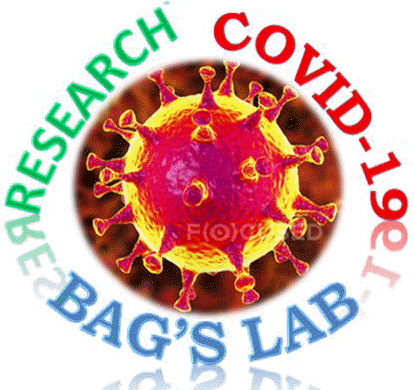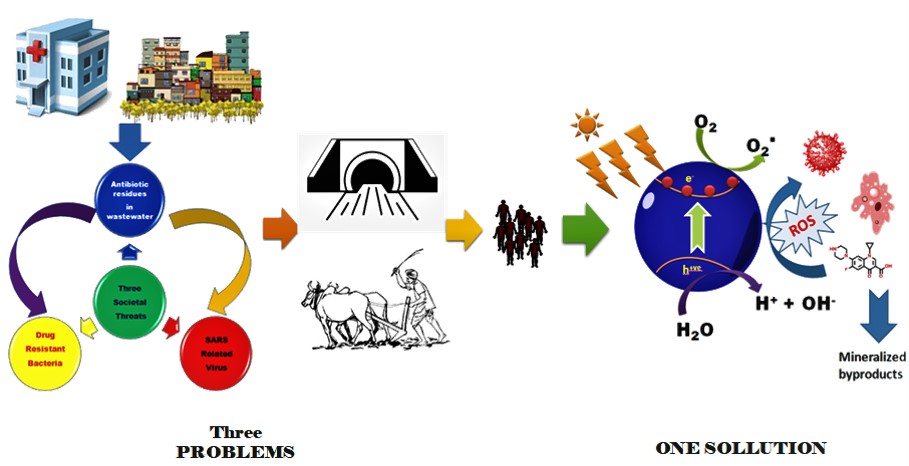|
Graphical Abstract
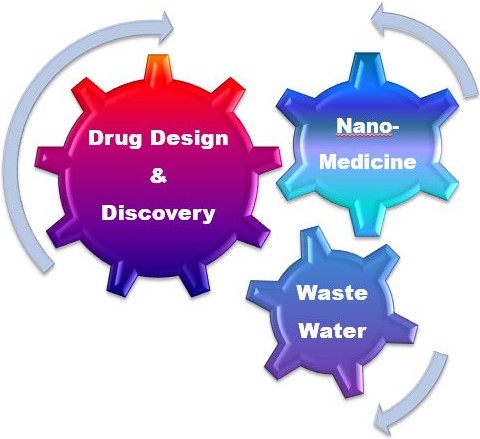
1. Nucleoside Based Anti SARS-CoV-2 Drug Design, Creation of Drug Library
and In Silico Computational Study
|
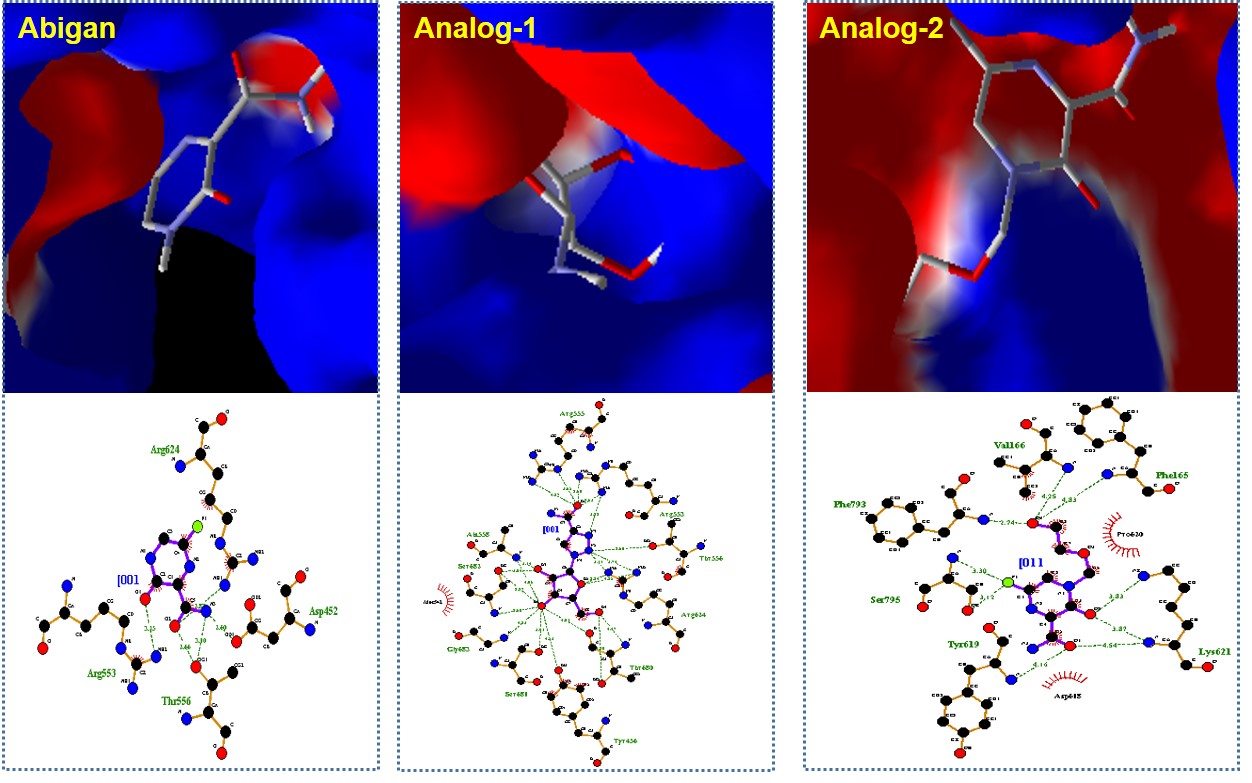
Our preliminary Molecular Docking study
suggested that the triazole containing bases shows strong
interaction and binding effect reflecting their activity to stop the
extension of RNA of the viruses. The target nucleosides
are believed to have mechanism of action which is similar to Avigan.
This work would yield a highly effective COVID-19 drug.
|
PUBLICATIONS
1.
●
A Systematic Review of the Efficacy and Safety of
Favipiravir (Avigan) for the Treatment of Novel COVID-19
Infections
●Bag*,
Subhendu Sekhar;
Sinha, Sayantan; and Saito, Isao
●
Medical Research Archives
2020, XX, XX (In Press).

2.
Bag*, S. S; Sinha S. S. Uncovering Potent
Inhibitory Activity of Our Reported Unnatural Triazolyl
Nucleobase Analogues Against SARS-CoV-2 RdRp:
An In Silico Study (Communicated).
3. Bag*,
S. S; Sinha S. S.; Saito, I. Proposed Avigan
Analoguous Unnatural Triazolyl Nucleosides as Potent
Inhibitors of SARS-CoV-2 RdRp: An In Silico
Study (Communicated).
5.
Bag*, S. S.; Sinha S. S. A Systematic Review
of the Efficacy and Safety of Remdesivir for the
Treatment of Novel COVID-19 Infections (Communicated).
6.
●
SARS-CoV-2 from Host Cell Entry, Pathogenicity to Possible
Remediation of the Infection Caused: An Overview● Bag*,
Subhendu Sekhar
and Sinha, Sayantan●
2020, XX, XX (Communicated).
|
2. Design, Synthesis and Therapeutic
Application of Novel Peptidomimetic Inhibitor Drugs (PIDs)
for COVID-19
|
We
have recently submitted a proposal to CSIR for funding based on "Design,
Synthesis and Therapeutic Application of Novel Peptidomimetic Inhibitor
Drugs (PIDs) for COVID-19".
Our design of peptidomimetic drug inhibitor (PID)
against SARS-CoV-2 Mpro main protease is proposed to starts
from a knowledge of substrate binding pocket, substrate and mechanism of
action of the potent inhibitors N3 and
a-ketoamide
based peptidic inhibitor. This understanding is a starting point for the
development of new SARS-CoV-2 Mpro inhibitors. We propose
that the variation of P1/P2 in our design would lead to potent N3-analog
and
a-keto
amide inhibitor, respectively. Initially we want to choose our unnatural
triazolyl aliphatic amino acid scaffold (AlTAA) to construct
our inhibitor. It is a β-Ala-Gly dipeptide mimic and when present in the
backbone of a Leu-Enkephalin analog sequence, it induces β-turn
structure, thus acting as β-turn-nucleator.
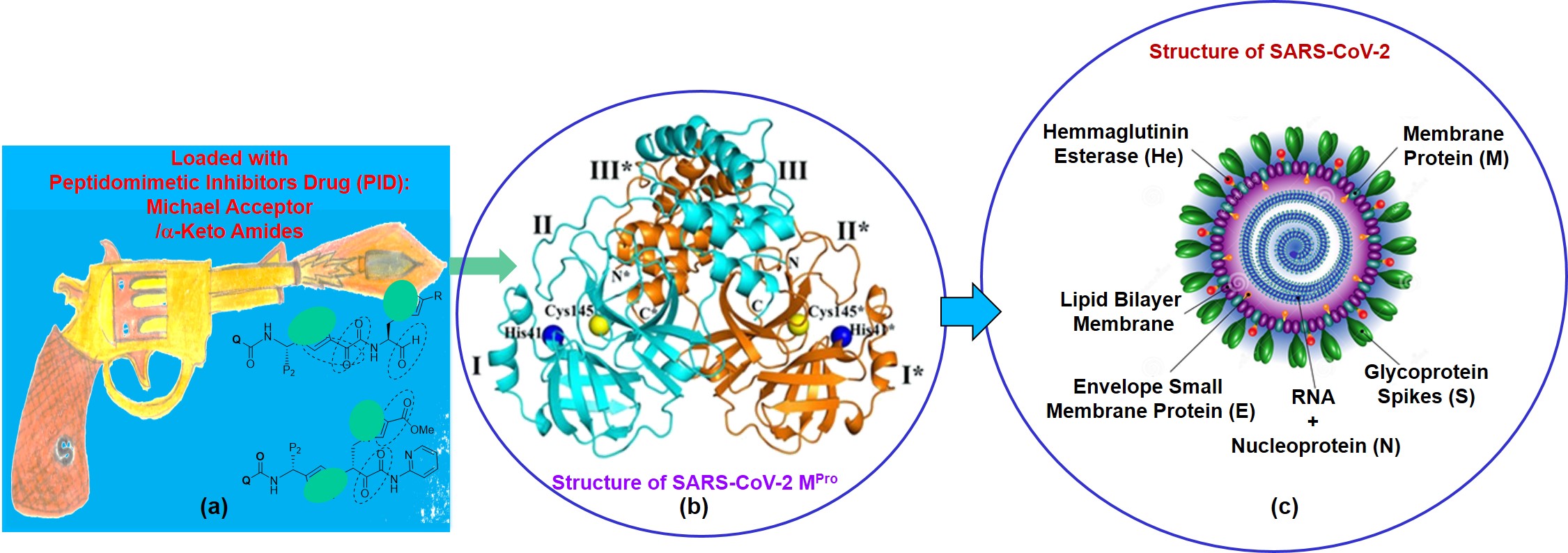
As
the SAR-CoV-2 Mpro specifically cleave the peptide bond following a
P1-glutamine residue we decided to use a 5-membered triazolyl ring which
can be a mimic of amide side chain of glutamine (which can be called as
Gln-Tz). This triazole moiety can enhance the power of the inhibitors
possibly due to rigid triazole ring which would lead to a reduction of
the loss of entropy upon binding to the target protease.
|
PUBLICATIONS
1. Bag*,
S. S; Sinha S. S. Uncovering Potent Inhibitory
Activity of Our Reported Peptidomimetic Designs Against
SARS-CoV-2 Mpro : An In Silico
Study (Communicated). |
3.
Design and Synthesis of a Smart Fluorescent Biogenic Nanocomposite that
Can (a) Stop nCoV-19 to Enter Into the Host Cell, (b) Detect the Virus
through Interaction and Photophysical Studies, and (c) Inhibit the
Activity of RNA Dependent RNA Polymerase (RdRp) to Strop Viral
Replication
4.
Application of the Smart FL-Biogenic Nanocomposite: (a) Anti-SARS-CoV-2
Nano-medicine and (b) Coating for Anti-SARS-CoV-2 Mask
|
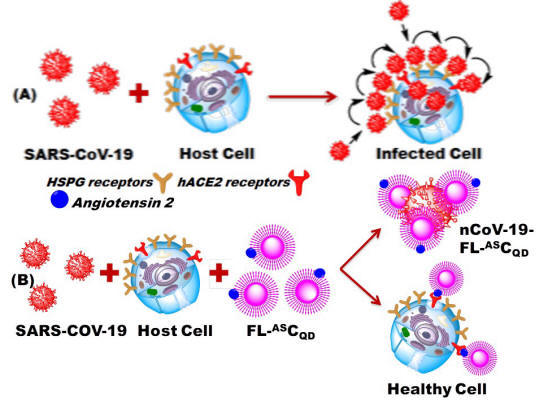
Anti-SARS-CoV-2 Nanomedicine:
The material is an antiviral biogenic fluorescent
Carbon Quantum Dot (FL-ASCQD), the
surface decorated with Angiotensin II which is the primary
substrate for human angiotensin-converting enzyme 2
(hACE2) receptors (a receptor that is utilized by
nCoV-19 for host cell entry). In addition, the
sulfate-decorated surface would act as a mimic of heparan
sulfate proteoglycan (HSPG) receptors of the host
cell. Therefore, in the presence of novel coronavirus, the
chemically modified nanomedicine would act as a competitive
binder of hACE2 receptor. Thus, it would serve as a
decoy to block all possible routes for entry into the cells.
So if the virus cannot locate its cellular entry receptor
(hACE2), there will be no chance of infection.
Additionally, the viral spiked glycoproteins will attach to
the HSPG mimics, and hence detection will be possible
through photo-physical studies. Finally, the generic
antiviral property of the nanomedicine will restrict the RNA
dependent RNA polymerase (RdRp) activity and hence stop
viral replication. |
PUBLICATIONS
This idea has been well
appreciated and selected amongst the top ideas in the "Undo
Corona Ideation Challenge," organized by
Government of Assam.
|
5. Cheap Solar Photocatalytic Process and Reactor for
Rapid, In-situ and at Source Removal of SARS Related Coronavirus,
Multi-drug Resistant Bacteria And Antibiotics From
Hospital/Community Generated Wastewater
6.
Fluorescent
Antimicrobial Peptide-based Bacteria/Virus Sensor
|
Fluorescent Antimicrobial
Peptide-based Bacteria/Virus Sensor:
We are now engaged in developing
bioinspired materials and
antimicrobial peptide based biomaterial for possible clinical use. We
are engaged in creating new and novel therapeutic alternatives against
the recent rise of multidrug-resistant microbial strains. We have put up
a project proposal based on the recent call for Team Science Grant
& Clinical/Public Health Research
Centres Grants from IndiaAlliance DBT. We want to exploit the
β-turn/β-sheet Peptidomimetics developed by Dr. Bag, Peptoids by Prof.
Aaron and the Surface tethering techniques by Prof. Lalit at BSBE
Department of IITG to create therapeutic surfaces. The bioinspired
materials based on fluorescent peptidomimetics developed by me
could also find applications in sensing and medical diagnostic purposes.
This project would have great impact to resist virus protein capsids,
such as SARS-CoV-2 and similar SARS viruses, from surface attachment.

|
|
Sl. No. |
Project Title |
Funding Agency |
Duration/ Total Cost |
Role PI/
Co-PI |
Status |
|
1. |
Design, Synthesis and Therapeutic
Application of Novel Peptidomimetic Inhibitor Drugs (PIDs)
for COVID-19
|
CSIR, Government of India |
3 years,
₹
25.2 Lakhs |
PI
|
Under Evaluation |
|
2. |
Synthesis of a Fluorescent
Sulphonated Biogenic Carbon Quantum Dot (FLSCQD)
Mimicking Heparan Sulphate Proteoglycan Cellular
Receptors and Inhibiting the Pathogenicity of SARS-CoV-2
virus |
DST-CRG Call on COVID-19,
Government of India
|
1 year;
₹
20.0 Lakhs
|
PI
|
Under Evaluation |
|
3. |
Mathematical Modelling of Transmittable Disease COVID-19
by Identifying Its Significant Chemical Factors: A
Cross-sectional Study of Malaria-Prone State, Tripura |
DST-SERB,
MATRICS special call on COVID-19
|
1 year
₹
5.0 Lakhs |
PI
[With Dr. Samrat Hore, Dept. of
Statistics, Tripura University] |
Under Evaluation
|
|
4. |
Rajadhiraj Yoga,
Asana and Meditation for Improving Immunity and to Get
Rid of Stress, Anxiety and Depression and Thus to Fight
Against Pandemic COVID-19.
|
DST special call
on COVID-19 under SATYAM |
1 year
₹
14.0 Lakhs |
Co-PI
[With Mr.
Bibhansu Maiti, Director, Kevalam Kalyan Kendra, New
Delhi] |
Under Evaluation |
|
5. |
The effects of Yogic meditation on
mental health and markers of immunity during COVID-19
lockdown |
DST special call
on COVID-19 under SATYAM |
1 year
₹
12.0 Lakhs |
Co-PI [With Sucharit
Katyal, AMPS, Kolkata] |
Under Evaluation |
|
6. |
Engineered Fluorescent Peptidomimetics for the Detection
of Bacteria
|
IndiaAlliance
DBT |
5 year
₹ 800 L |
Co-PI |
Under
Evaluation
|
|
7. |
Development of a Cheap Solar
Photocatalytic Process for Rapid Prevention
of SARS-CoV-2 outbreak and
Spread from Hospital/Community Generated Wastewater |
DBT-BIRAC
Call on COVID-19
|
2 years,
₹
40.0 Lakhs |
PI |
Final Stage Evaluation
|
|
8.
|
Combinatorial
delivery of Hydroxy Chloroquin and Remdesivir Using a
Liposomal Formulation |
USISTEF-
Call
on
COVID-19
|
1.5 years;
35.0 Lakhs |
PI
Co-PI-Dr. D. Pan, University of
Maryland, USA |
Under Evaluation |
|

